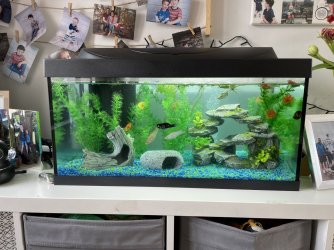Hi,
I’m Becki and I’m very new to tropical fish! We’ve recently got a 54l tank (h37cm, w33cm, d62cm) and it has been up and running for about 2.5 weeks now. This is a new hobby for myself and our young sons to enjoy so I really really want to get this right as we sadly lost a Molly yesterday and our 5 year old was heart broken!
Naively we followed the advice of P@H and decided to do fish-in cycling after 24 hours, with 4 male mollies and 4 snails (2 red spotted and 2 zebra). 3 of the snails didn’t make it past 3 days and we sadly lost our first fish yesterday after 15 days. After reading up quite a bit I got advice from a local aquatics centre who have regularly been testing our water which is high in nitrite. They’ve advised that we cut feeding to once every other day and do at least a 10% water change daily. I’ve been using dechlorinator and have also put in8 bacterial balls over the last couple of weeks at their advice. Yesterday I did a 50% water change and put 4 balls in as I was advised and now I’m paranoid that that is what killed the fish and I’m worried about doing this again? I’m also worried that the other fish are now at risk, although they seem okay so far.
So my most urgent question is about saving the mollies and snail that we currently have. My plan is to keep doing the 10% changes daily with dechlorinator and feeding every other day. The shop suggested that I did another 50% water change on Friday but I’m now wary of doing this?
Going forward our plan for stocking a community tank is to get guppies next, then corydoras (maybe Pygmy?), possibly African dwarf frogs, tetra and possibly something else. This is with advice from the aquatics centre, does this sound okay? If so what numbers of each should we go for? I know corydoras and tetras like larger groups and we’d ideally like at least 3 male guppies.
In case It’s relevant, we’re just outside of Bristol so apparently our water is quite good (??), we currently have plastic plants and gravel but we have added real floating plants, we’ve got a filter and heater and we’ve also added an air stone. We’ve also got several fish safe ornaments for the fish to hide in/explore.
Apologies for the rambling post and many thanks in advance for advice - I’ve been confusing myself googling everything about tropical fish and the advice can be very contradictory!
I’m Becki and I’m very new to tropical fish! We’ve recently got a 54l tank (h37cm, w33cm, d62cm) and it has been up and running for about 2.5 weeks now. This is a new hobby for myself and our young sons to enjoy so I really really want to get this right as we sadly lost a Molly yesterday and our 5 year old was heart broken!
Naively we followed the advice of P@H and decided to do fish-in cycling after 24 hours, with 4 male mollies and 4 snails (2 red spotted and 2 zebra). 3 of the snails didn’t make it past 3 days and we sadly lost our first fish yesterday after 15 days. After reading up quite a bit I got advice from a local aquatics centre who have regularly been testing our water which is high in nitrite. They’ve advised that we cut feeding to once every other day and do at least a 10% water change daily. I’ve been using dechlorinator and have also put in8 bacterial balls over the last couple of weeks at their advice. Yesterday I did a 50% water change and put 4 balls in as I was advised and now I’m paranoid that that is what killed the fish and I’m worried about doing this again? I’m also worried that the other fish are now at risk, although they seem okay so far.
So my most urgent question is about saving the mollies and snail that we currently have. My plan is to keep doing the 10% changes daily with dechlorinator and feeding every other day. The shop suggested that I did another 50% water change on Friday but I’m now wary of doing this?
Going forward our plan for stocking a community tank is to get guppies next, then corydoras (maybe Pygmy?), possibly African dwarf frogs, tetra and possibly something else. This is with advice from the aquatics centre, does this sound okay? If so what numbers of each should we go for? I know corydoras and tetras like larger groups and we’d ideally like at least 3 male guppies.
In case It’s relevant, we’re just outside of Bristol so apparently our water is quite good (??), we currently have plastic plants and gravel but we have added real floating plants, we’ve got a filter and heater and we’ve also added an air stone. We’ve also got several fish safe ornaments for the fish to hide in/explore.
Apologies for the rambling post and many thanks in advance for advice - I’ve been confusing myself googling everything about tropical fish and the advice can be very contradictory!


